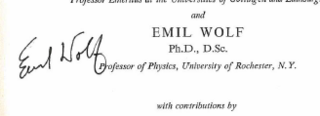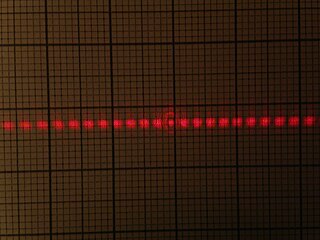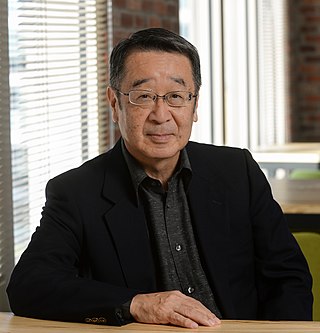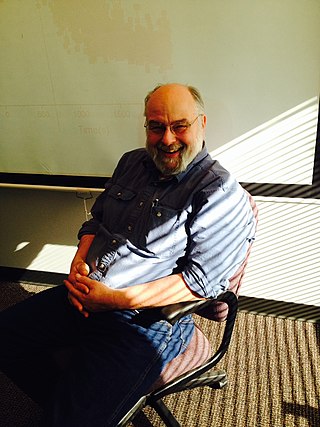Related Research Articles

In physics, a plasmon is a quantum of plasma oscillation. Just as light consists of photons, the plasma oscillation consists of plasmons. The plasmon can be considered as a quasiparticle since it arises from the quantization of plasma oscillations, just like phonons are quantizations of mechanical vibrations. Thus, plasmons are collective oscillations of the free electron gas density. For example, at optical frequencies, plasmons can couple with a photon to create another quasiparticle called a plasmon polariton.
In physics, coherence expresses the potential for two waves to interfere. Two monochromatic beams from a single source always interfere. Physical sources are not strictly monochromatic: they may be partly coherent. Beams from different sources are mutually incoherent.

Emil Wolf was a Czech-born American physicist who made advancements in physical optics, including diffraction, coherence properties of optical fields, spectroscopy of partially coherent radiation, and the theory of direct scattering and inverse scattering. He was also the author of numerous other contributions to optics.
Quantum optics is a branch of atomic, molecular, and optical physics dealing with how individual quanta of light, known as photons, interact with atoms and molecules. It includes the study of the particle-like properties of photons. Photons have been used to test many of the counter-intuitive predictions of quantum mechanics, such as entanglement and teleportation, and are a useful resource for quantum information processing.

Electromagnetically induced transparency (EIT) is a coherent optical nonlinearity which renders a medium transparent within a narrow spectral range around an absorption line. Extreme dispersion is also created within this transparency "window" which leads to "slow light", described below. It is in essence a quantum interference effect that permits the propagation of light through an otherwise opaque atomic medium.
Nanophotonics or nano-optics is the study of the behavior of light on the nanometer scale, and of the interaction of nanometer-scale objects with light. It is a branch of optics, optical engineering, electrical engineering, and nanotechnology. It often involves dielectric structures such as nanoantennas, or metallic components, which can transport and focus light via surface plasmon polaritons.

Extraordinary optical transmission (EOT) is the phenomenon of greatly enhanced transmission of light through a subwavelength aperture in an otherwise opaque metallic film which has been patterned with a regularly repeating periodic structure. Generally when light of a certain wavelength falls on a subwavelength aperture, it is diffracted isotropically in all directions evenly, with minimal far-field transmission. This is the understanding from classical aperture theory as described by Bethe. In EOT however, the regularly repeating structure enables much higher transmission efficiency to occur, up to several orders of magnitude greater than that predicted by classical aperture theory. It was first described in 1998.

The Institute of Optics is a department and research center at the University of Rochester in Rochester, New York. The institute grants degrees at the bachelor's, master's and doctoral levels through the University of Rochester School of Engineering and Applied Sciences. Since its founding, the institute has granted over 2,500 degrees in optics, making up about half of the degrees awarded in the field in the United States. The institute is made up of 20 full-time professors, 12 professors with joint appointments in other departments, 10 adjunct professors, 5 research scientists, 11 staff, about 170 undergraduate students and about 110 graduate students.

Surface plasmons (SPs) are coherent delocalized electron oscillations that exist at the interface between any two materials where the real part of the dielectric function changes sign across the interface. SPs have lower energy than bulk plasmons which quantise the longitudinal electron oscillations about positive ion cores within the bulk of an electron gas.
A spaser or plasmonic laser is a type of laser which aims to confine light at a subwavelength scale far below Rayleigh's diffraction limit of light, by storing some of the light energy in electron oscillations called surface plasmon polaritons. The phenomenon was first described by David J. Bergman and Mark Stockman in 2003. The word spaser is an acronym for "surface plasmon amplification by stimulated emission of radiation". The first such devices were announced in 2009 by three groups: a 44-nanometer-diameter nanoparticle with a gold core surrounded by a dyed silica gain medium created by researchers from Purdue, Norfolk State and Cornell universities, a nanowire on a silver screen by a Berkeley group, and a semiconductor layer of 90 nm surrounded by silver pumped electrically by groups at the Eindhoven University of Technology and at Arizona State University. While the Purdue-Norfolk State-Cornell team demonstrated the confined plasmonic mode, the Berkeley team and the Eindhoven-Arizona State team demonstrated lasing in the so-called plasmonic gap mode. In 2018, a team from Northwestern University demonstrated a tunable nanolaser that can preserve its high mode quality by exploiting hybrid quadrupole plasmons as an optical feedback mechanism.

Alexey V. Kavokin is a Russian and French theoretical physicist and writer.

Yoshihisa Yamamoto is the director of Physics & Informatics Laboratories, NTT Research, Inc. He is also Professor (Emeritus) at Stanford University and National Institute of Informatics (Tokyo).
A plasmonic metamaterial is a metamaterial that uses surface plasmons to achieve optical properties not seen in nature. Plasmons are produced from the interaction of light with metal-dielectric materials. Under specific conditions, the incident light couples with the surface plasmons to create self-sustaining, propagating electromagnetic waves known as surface plasmon polaritons (SPPs). Once launched, the SPPs ripple along the metal-dielectric interface. Compared with the incident light, the SPPs can be much shorter in wavelength.
Photonic molecules are a form of matter in which photons bind together to form "molecules". They were first predicted in 2007. Photonic molecules are formed when individual (massless) photons "interact with each other so strongly that they act as though they have mass". In an alternative definition, photons confined to two or more coupled optical cavities also reproduce the physics of interacting atomic energy levels, and have been termed as photonic molecules.

Duncan G. Steel is an American experimental physicist, researcher and professor in quantum optics in condensed matter physics. He is the Robert J. Hiller Professor of Electrical Engineering, Professor of Physics, Professor of Biophysics, and Research Professor in the Institute of Gerontology at the University of Michigan. Steel is also a Guggenheim Scholar and a Fellow of American Physical Society, the Optical Society of America, and the Institute of Electrical and Electronics Engineers. He coedited the five-volume series on the Encyclopedia of Modern Optics.
Ortwin Hess is a German-born theoretical physicist at Trinity College Dublin (Ireland) and Imperial College London (UK), working in condensed matter optics. Bridging condensed matter theory and quantum optics he specialises in quantum nanophotonics, plasmonics, metamaterials and semiconductor laser dynamics. Since the late 1980s he has been an author and coauthor of over 300 peer-reviewed articles, the most popular of which, called "'Trapped rainbow' storage of light in metamaterials", was cited more than 400 times. He pioneered active nanoplasmonics and metamaterials with quantum gain and in 2014 he introduced the "stopped-light lasing" principle as a novel route to cavity-free (nano-) lasing and localisation of amplified surface plasmon polaritons, giving him an h-index of 33.
Integrated quantum photonics, uses photonic integrated circuits to control photonic quantum states for applications in quantum technologies. As such, integrated quantum photonics provides a promising approach to the miniaturisation and scaling up of optical quantum circuits. The major application of integrated quantum photonics is Quantum technology:, for example quantum computing, quantum communication, quantum simulation, quantum walks and quantum metrology.

Carlos Ray Stroud, Jr. is an American physicist and educator. Working in the field of quantum optics, Stroud has carried out theoretical and experimental studies in most areas of the field from its beginnings in the late 1960s, studying the fundamentals of the quantum mechanics of atoms and light and their interaction. He has authored over 140 peer-reviewed papers and edited seven books. He is a fellow of the American Physical Society and the Optical Society of America, as well as a Distinguished Traveling Lecturer of the Division of Laser Science of the American Physical Society. In this latter position he travels to smaller colleges giving colloquia and public lectures.

Nabil Mishreky Lawandy is an American physicist, inventor, academic, and businessman. After 18 years as a professor of Engineering and Physics at Brown University, Lawandy founded Spectra Systems Corporation. He is currently the President, and Chief Executive Officer of Spectra Systems Corporation, a London Stock Exchange-listed company and is currently a Professor of Research at Brown University in the School of Engineering. Technology invented by Lawandy is used by many of the world's central banks to protect against counterfeiting of banknotes.
Mark Stockman was a Soviet-born American physicist. He was a professor of physics and astronomy at Georgia State University. Best known for his contributions to plasmonics, Stockman has co-theorized plasmonic lasers, also known as spasers, in 2003.
References
- ↑ Academia Greg Gbur
- 1 2 Nonradiating Sources and the Inverse Source Problem by Greg Gbur, Department of Physics and Astronomy, University of Rochester
- ↑ Curriculum Vitae Greg Gbur, Full Professor, UNC Charlotte
- ↑ Singular Optics by * Greg Gbur Review by Christian Brosseau, The Optical Society, May 18, 2017.
- ↑ Greg Gbur: Profile The International Society of Optics and Photonics
- ↑ Smith, Matt K.; Gbur, Gregory J. (2016). "Construction of arbitrary vortex and superoscillatory fields". Optics Letters. 41 (21): 4979–4982. Bibcode:2016OptL...41.4979S. doi: 10.1364/ol.41.004979 . PMID 27805664.
- ↑ Gbur, Greg (2019). "Using superoscillations for superresolved imaging and subwavelength focusing". Nanophotonics. 8 (2): 205–225. doi: 10.1515/nanoph-2018-0112 . S2CID 125247006.
- ↑ "2021 OSA Fellows". The Optical Society . Retrieved October 9, 2020.
- ↑ Chopping down the Beanstalk The Renaissance Mathematicus, May 26, 2014
- ↑ Alea Iacta Est! The Giant's Shoulders: A monthly blog carnival about classic science papers
- ↑ Skulls in the Stars The intersection of physics, optics, history and pulp fiction
- ↑ G. Gbur, “Invisibility physics: Kerker’s ‘invisible bodies'”, in B. Zivkovic, J. Goldman (Eds.), The Open Laboratory 2010 (Coturnix, Chapel Hill, 2010), p. 179. (original online post)
- ↑ G. Gbur, “Mpemba’s baffling discovery,” in Best Science Writing Online 2012, J. Ouellette and B. Zivkovic, eds. (Scientific American, New York, 2012), 108.
- ↑ Review of Science Blogging: The Essential Guide by Sarah Boon in Medium, December 1, 2018
- ↑ Publications Greg Gbur, Dept of Physics & Optical Science, UNC Charlotte
- ↑ Broken Boy by John Blackburn With a new introduction by Greg Gbur
- ↑ Books with introduction by Greg Gbur Amazon.com
- ↑ Devil in the Darkness Archived 2019-12-28 at the Wayback Machine by Archie Roy with an all new introduction by Greg Gbur, April 13, 2017
- ↑ Gbur, Greg (2003). Nonradiating sources and other "invisible" objects. Progress in Optics. Vol. 45. pp. 273–315. doi:10.1016/S0079-6638(03)80007-0. ISBN 9780444513342.
- ↑ Gbur, G.; Visser, T.D. (2010). The Structure of Partially Coherent Fields. Progress in Optics. Vol. 55. pp. 285–341. doi:10.1016/B978-0-444-53705-8.00005-9. ISBN 9780444537058.
- ↑ Gbur, Greg (2013). Invisibility Physics: Past, Present, and Future. Progress in Optics. Vol. 58. pp. 65–114. doi:10.1016/B978-0-444-62644-8.00002-9. ISBN 9780444626448.